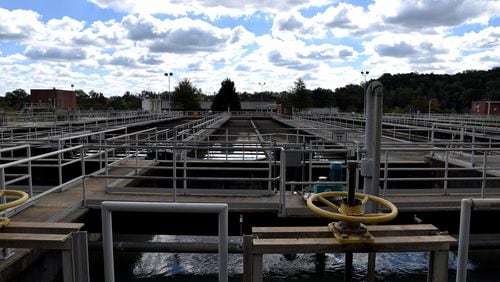It’s more than the stench that’s an issue when raw sewage overflows in metro Atlanta.
Despite billions of dollars in sewer system improvements and a decrease in the number of spills, the problems persist, particularly in intown areas, where pipes are older and people are more tightly packed.
The result is consistent frustration and health hazards, even as fixes are in the works.
All too often, the pipes that carry waste clog, spilling sewage into local streams. It pollutes the water and causes public health risks.
In Atlanta's Buckhead Memorial Park, raw sewage has gushed near a park where children play. The city plans to spend $40 million to fix the issue. Some DeKalb County homeowners complain of streams of wastewater flowing through their yards.
After more than 147 million gallons of wastewater spilled into the Chattahoochee River since 2011, the city of Atlanta is preparing to pay $378,000 in fines to the Georgia Environmental Protection Division. DeKalb's government is being investigated for underreporting spills.
Region-wide, sewage mishaps have plunged 57 percent, from 1,452 in 2001 to 627 in 2014, according to the Atlanta Regional Commission.
“A lot of people have the perception that we’ve had more spills than usual,” said Lewis Hays, a manager for the Georgia EPD. “The main thing is to demonstrate improvement, to show a decrease in the number of spills and especially be able to address them when they’re at repeat locations.”
The city of Atlanta and DeKalb County remain the region's most troubled areas for sewage spills, though both continue to spend on long-term improvements to sewer facilities and pipes. In contrast, Gwinnett, with newer infrastructure, has fewer problems. Fulton and Cobb counties fall in the middle.
Aging infrastructure and their dense, urban environments make Atlanta and DeKalb more susceptible to spills, said Danny Johnson, manager of the Metropolitan North Georgia Water Planning District.
As money is spent to improve the pipes in those areas and modernize the materials, an education campaign has also made a difference. Flushed wipes, oils and grease greatly contribute to clogged pipes, and with fewer people putting them down the drain, the number of spills has decreased.
In Atlanta, spills declined from 454 in 2002 to 194 last year; in DeKalb, spills have shrunk from 180 in 2011 to 116 last year, though investigators are questioning the accuracy of those numbers.
State and federal environmental agencies are reviewing DeKalb's numbers after the county acknowledged misreporting sewer spills. The county fired a watershed manager and hired an outside company to review the extent of the issue. DeKalb could face fines from EPD and the U.S. Environmental Protection Agency at the conclusion of the investigation.
DeKalb is in the middle of a $1.3 billion infrastructure upgrade project. A significant reduction in sewage spills in DeKalb will come after hundreds of miles of new pipes are installed in the next couple of years, said Zach Williams, the county's chief operating officer. So far, much of the county's work has been to replace wastewater treatment facilities and lift stations.
“We know how far we have to go and how much more sewer replacement we have to do, and the major construction is in the years to come,” Williams said. “As we continue to move forward … you’re going to see the decrease.”
Atlanta has been already been working since 1998, when a federal judge ordered the city to make fixes. The city finished separating many waste and stormwater lines in 2008 to comply with the order, and it is now replacing lines that carry only raw sewage. Those sanitary sewer line improvements are scheduled for completion in 2027. In all, the improvements will cost about $4 billion.
“Work is being accomplished to reduce spills,” said Lillian Govus, a spokeswoman for Atlanta’s Department of Watershed Management. “Several key projects add sewer capacity to reduce spills and overflows during storm events.”
Gwinnett County generally has the fewest spills annually in the core metro Atlanta region, according to EPD spill report numbers, despite being among those areas with the largest population with more than 895,000 people last year.
Gwinnett has a younger system and newer pipes, said Rebecca Shelton, the deputy director of field operations for the county’s department of water resources. While older pipes are largely made of clay, the new ones are primarily PVC or ductile iron, which is meant to last longer. Additionally, Shelton said, clay pipes hold onto grease more easily, exacerbating the problem of age.
Gwinnett has a “pretty aggressive” cleaning program to clear out debris, including tree roots. Being proactive helps keep the number of spills in the county relatively low, she said.
“You don’t want that in your creeks,” she said.
Sanitary sewer overflows in metro Atlanta
2001: 1,452
2002: 1,330
2003: 1,140
2004: 1,151
2005: 1,266
2006: 1,149
2007: 907
2008: 844
2009: 909
2010: 769
2011: 730
2012: 635
2013: 635
2014: 627
Source: Georgia Environmental Protection Division and Metropolitan North Georgia Water Planning District









